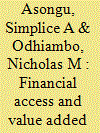|
|
|
Sort Order |
|
|
|
Items / Page
|
|
|
|
|
|
|
| Srl | Item |
| 1 |
ID:
186390


|
|
|
|
|
| Summary/Abstract |
This research assesses the importance of financial access on value added in three economic sectors in 25 countries in Sub-Saharan Africa using data for the period 1980–2014. The empirical evidence is based on the Generalized Method of Moments. Financial access is measured with private domestic credit, while the three outcome variables are: value added in the agricultural, manufacturing, and service sectors, respectively. Enhancing financial access does not significantly improve value added in the agricultural and manufacturing sectors, while enhancing financial access improves value added in the service sector. An extended analysis shows that, in order for the positive net incidence of enhancing credit access on value added to the service sector to be maintained, complementary policies are required when domestic credit to the private sector is between 77.50 percent and 98.50 percent of GDP. Policy implications are discussed.
|
|
|
|
|
|
|
|
|
|
|
|
|
|
|
|
| 2 |
ID:
099776


|
|
|
|
|
| Summary/Abstract |
China and Mexico embarked, around the early 1980s, on the process of liberalization of trade and FDI and established some export oriented industries through assembly operations with the help of FDI. Both countries had the same objective of increasing value added in export processing industries. The authors examine the comparative achievements of their common objectives in the light of the export oriented strategy hypothesis. Applying the indicators of Revealed Comparative Advantage to exports and imports, the authors show that while there are some similarities in the performance of the two countries, there are also striking differences. Both have managed to increase manufactured exports, particularly in IT products, significantly during 1990s. Both, but particularly China, have developed comparative advantage in export and production of many industries, which had been initiated through import substitution. However, Mexico has achieved little, compared with China, in increasing value added in exports and in developing comparative advantage in production in assembly operations. Further, unlike China, since the early years of the 2010 decade it has not been able to sustain its rapid export growth.
|
|
|
|
|
|
|
|
|
|
|
|
|
|
|
|
| 3 |
ID:
161823


|
|
|
|
|
| Summary/Abstract |
This study first traces value added in gross exports of China during 2000–2014 to four components, namely domestic value added absorbed abroad (DVA), domestic value added return home (RDV), foreign value added (FVA), and pure double-counted terms (PDC), then compares these four components in China's exports with those in exports of the USA, Japan, Korea, and India. Second, this paper proposes a generalized logarithmic mean Divisia index (GLMDI) method and combines additive and multiplicative decomposition to decompose DVA gaps between China and the other four countries into value added coefficient effect, input-output structure effect, domestic scale effect and foreign scale effect. The aggregate value added coefficient effect is then attributed to sectoral level. Results show that DVA always occupied the largest share in the gross exports of China, which ranged from 74.60–82.84% during 2000–2014. Before 2011, DVA share of China's exports was generally the second smallest among five countries; since 2011, DVA share of China's exports increased, and China had the largest DVA share in 2014 (81.39%). Sectors having a large FVA share in China's exports usually had a large DVA share, such as “Mining” (MIN), “Computers, Electronic and Optical” (CEO), and “Basic Metals” (BAS). Additive and multiplicative decomposition analyses indicate that value added coefficients had a negative and increased effect on DVA gaps between China and the other four countries. Attribution analysis revealed that CEO sector had the largest negative value added coefficient effect in comparison between China and the USA, Japan, and Korea and its effect increased in comparison between China and the other four countries. Policy implications derived are finally discussed.
|
|
|
|
|
|
|
|
|
|
|
|
|
|
|
|
|
|
|
|
|